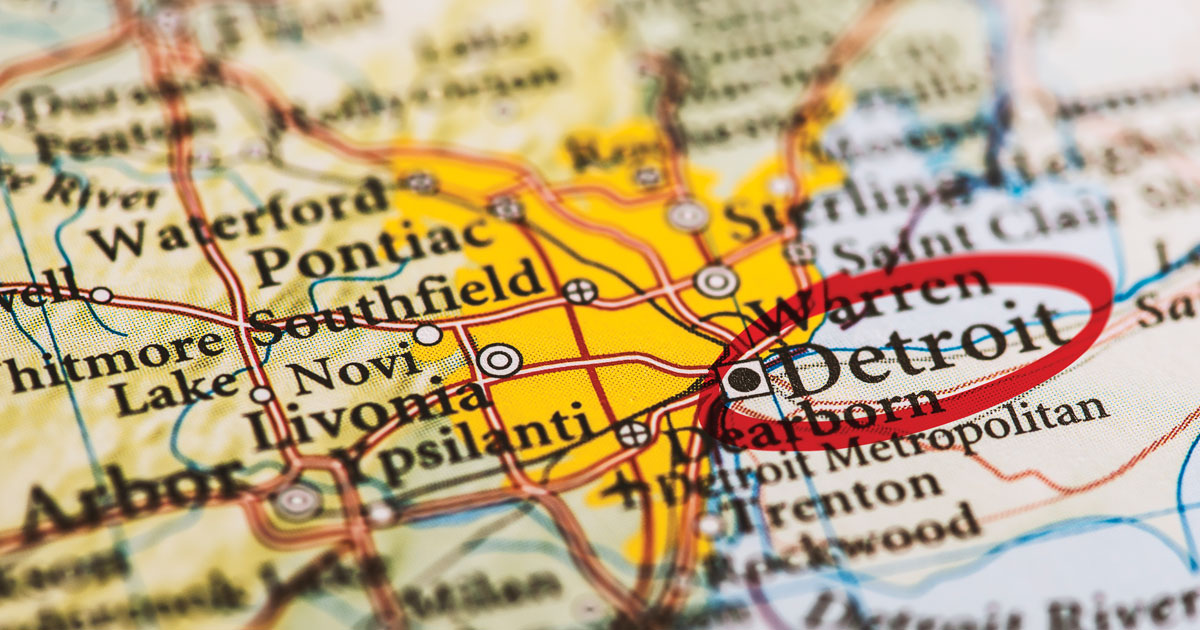 In 1913, Ford Motor Co. attempted to assimilate its diverse workforce by creating an English school to help non-native speakers communicate, according to The Henry Ford Museum. Once these workers earned their diplomas, they attended a graduation ceremony wearing their homelandÔÇÖs traditional dress and entered a stage-prop cauldron bearing a banner that read, ÔÇ£American Melting Pot.ÔÇØ When they exited, they were wearing contemporary American suits.
In 1913, Ford Motor Co. attempted to assimilate its diverse workforce by creating an English school to help non-native speakers communicate, according to The Henry Ford Museum. Once these workers earned their diplomas, they attended a graduation ceremony wearing their homelandÔÇÖs traditional dress and entered a stage-prop cauldron bearing a banner that read, ÔÇ£American Melting Pot.ÔÇØ When they exited, they were wearing contemporary American suits.
Though a seemingly kitschy and antiquated representation of the concept of assimilation, immigrants happily cast off their old identities for the prosperity Ford promised. Yet over a century later, the concept of true integration in metro Detroit still seems far out of reach. Today, southeast Michigan remains one of the most segregated and inequitable regions in the country.
Overwhelmingly across the region, people donÔÇÖt live around those who are different from them, whether that be due to class, race, ethnicity, or religion. Most of metro DetroitÔÇÖs many cities and townships are predominantly White Anglo-Saxon Protestant, while minorities tend to cluster in enclaves or more diverse inner-ring cities.
These patterns are not unprecedented. Both before and after metro DetroitÔÇÖs population explosion from 1900-1950, racism and discrimination in the area were rampant. From the violent removal of indigenous peoples from their traditional lands and the Sweet Trials (the 1925 case of African-American physician Ossian Sweet, who was threatened by a white mob after buying a house in an all-white Detroit neighborhood), to the 1943 and ÔÇÖ67 race riots and the racially motivated murder of Vincent Chin in 1982, the specter of prejudice in southeast Michigan has been looming for generations.
Over 100 years later, the accepted definition of a ÔÇ£melting potÔÇØ has changed; metro Detroit, however, hasnÔÇÖt. It remains one of the most segregated and inequitable regions in the country.
Scrapes in Southfield
In 1950, DetroitÔÇÖs population peaked at 1.8 million residents, and itÔÇÖs been plummeting ever since. The initial blow was caused by WASPs flocking to the suburbs, but other groups soon followed. By the 1970s, African-Americans had begun to leave, too. Mayor of Southfield Kenson Siver, 72, can track this trend better than most, as heÔÇÖs called the city his home for more than 50 years. He moved to metro Detroit from Hackensack, N.J., in the ÔÇÖ60s and previously lived in Pontiac and Royal Oak. Southfield was known for being progressive then, he says, and many of its residents were well-off Jewish families who faced anti-Semitism elsewhere.
Siver, who is white, says his landlord in Royal Oak was reluctant to have a single, young man as a tenant, assuming he would cause trouble. Eventually, though, she offered him a unit and loaned him furniture on the condition that he never talk to ÔÇ£the blacksÔÇØ who lived on the first floor. He soon learned ÔÇ£the blacksÔÇØ were two sisters of European Jewish heritage. When the landlord saw him chatting with the women, she demanded her furniture back. Siver moved to Southfield soon after.

There are currently seven synagogues there, and while its demographics have shifted from predominately white and Jewish to majority black over the past 20 years, Southfield overall has ÔÇ£embraced diversity and tolerance,ÔÇØ Siver writes in his book, Southfield: The History of Our City in its 50th Year (Southfield, 2009). Still, people of color and non-Christians couldnÔÇÖt own homes in neighboring Lathrup Village in the 1920s, and perceptions of Southfield have worsened as the population has become more diverse. In 1972, Siver bought his current home in SouthfieldÔÇÖs Magnolia neighborhood from owners who had disapproved of a black family moving in two doors down. Even now, he says acquaintances express confusion when they find out heÔÇÖs still there.

ÔÇ£Overall, IÔÇÖve always been very comfortable here,ÔÇØ he explains. ÔÇ£When I was a kid [and] IÔÇÖd get mad at something, or somebody had done something ÔǪ my mother would say, ÔÇÿWeÔÇÖre taking the high road. ÔǪ DonÔÇÖt go where theyÔÇÖre going.ÔÇÖ And of course, she was absolutely right.ÔÇØ
Siver, an openly gay man, faced discrimination himself during his 2015 mayoral run, when campaign signs were vandalized with offensive homophobic slurs. Flyers linking his platform to anti-black statements also reportedly circulated. Siver says that he believes it was an attempt to discredit him among black voters. ÔÇ£There were people that said, ÔÇÿYou know, this is a black city, we should have a black mayor.ÔÇÖ I think we should have a qualified person,ÔÇØ he says. ÔÇ£I donÔÇÖt care what they look like.ÔÇØ
Myriad recent investments by the City of Southfield promise to greatly improve quality of life and opportunity for residents. A 1-mile stretch of Evergreen Road in front of Southfield City Centre underwent a $12 million renovation in 2014-15, the city purchased the shuttered Northland Center for $2.4 million around the same time, and redevelopment is ongoing. But thereÔÇÖs still the constant threat of what Siver calls ÔÇ£The Moving Dance.ÔÇØ ItÔÇÖs a disheartening phenomenon that he has noticed consistently over the years, where a single violent incident receives widespread media attention and in turn convinces some people that the area isnÔÇÖt safe and itÔÇÖs time to pick up and leave.
And thereÔÇÖs most definitely a racial component to which incidents cause the most furor, he notes. In 2017, a violent shooting at Bar 7 at the corner of Telegraph and 12 Mile roads prompted one Detroit News reader to comment online, ÔÇ£Welcome to Southfield, ÔÇÿthe new Detroit.ÔÇÖ ÔÇØ
ÔÇ£ItÔÇÖs really about getting to know people,ÔÇØ Siver says. ÔÇ£Being gay, I know what prejudice feels like. I have been physically assaulted, I have been called every name in the book, I have been marginalized growing up as a young person. It only has to happen once or twice. Why would I do that to you? I know how that feels.ÔÇØ
Native Hardships
Fay Givens, a citizen of the Mississippi Band of Choctaw Indians and executive director of American Indian Services Inc. in Lincoln Park, grew up in southwest Detroit. In 1955, when she was only a young girl, the Indian Relocation Act forced her and her family to move from their home reserve as part of a plan to integrate more Natives into cities. Givens, who also has Cherokee ancestry, says the relocation period was one of countless examples of cultural genocide against American Indians. ÔÇ£They had a map of the whole country and decided how they were going to break up the tribes,ÔÇØ she says. ÔÇ£A lot of the Choctaw people went to Chicago, but it was just a scattering of us all over the country.ÔÇØ Still, she learned to appreciate the new experiences that Detroit offered.

ÔÇ£All of a sudden we were in a place where there were Italians, and French, and all these other groups of people who we had never known anything about, because where we lived we were basically related to everybody,ÔÇØ Givens says. ÔÇ£We were very, very curious about other ethnic groups.ÔÇØ Likewise, the other ethnic groups present in the area were unfamiliar with GivensÔÇÖ heritage. ÔÇ£Kids in the neighborhood would say, ÔÇÿYour dadÔÇÖs a MexicanÔÇÖ ÔǪ because they werenÔÇÖt used to [us], although Indians had always lived in Detroit.ÔÇØ
Michigan is the traditional homeland of Anishinaabek (Ojibwe, Potawatomi, Ottawa) and Haudenosaunee (a group of nations often collectively referred to as ÔÇ£IroquoisÔÇØ) peoples. To the Wyandot, an Iroquoian people, Detroit is ÔÇ£Oppenago,ÔÇØ or the ÔÇ£city of stones,ÔÇØ because it served as a waypoint for Natives making their way to Flint for the namesake rock used to craft arrowheads, Givens says.
American Indians relationship to the city permanently changed, however, when European settlers arrived; they were no longer welcome at Fort Detroit after sunset. And today, conditions havent improved much. We have the lowest level of educational attainment; were at the bottom of every socioeconomic indicator in America, Givens says. Theres been no commitment to do anything for us  its talk.  What we have experienced here is a constant wave of budget cuts.
ÔÇ£White folks want to stay around all white folks, even though we had a great neighborhood.ÔÇØ
ÔÇö Byron Nolen, Mayor of Inkster
Today, there are roughly 65,000 American Indians living in the tri-county area, and Wayne County has the largest American Indian population in the state. But there are only three nonprofit Native agencies in the region. Although American Indian Services Inc. is small, and Givens stresses the need for state and federal governments to honor their treaties with American Indians, she takes pride in her work. ÔÇ£As Indian people, we feel responsibility for each other, and so we continue with that ÔÇö itÔÇÖs one of our core values,ÔÇØ she says. ÔÇ£And so thatÔÇÖs enabled us to survive in the cities.ÔÇØ
As for the growing reinvestment in Detroit, Givens has mixed feelings. On one hand, she says it benefits urban American Indians because most men in the community are construction workers. But she also knows they wonÔÇÖt ultimately reap any rewards when the dust settles.
ÔÇ£[American Indians are] not considered at all in the conversation,ÔÇØ she says. ÔÇ£If youÔÇÖre not at the table, youÔÇÖre on the menu. That would be us.ÔÇØ
Southwestern Segregation
The city of Inkster and Garden City are in many ways microcosms of metro Detroit as a whole. Garden City is 94 percent white; Inkster is 75 percent black. They have similar population sizes and are both working-class communities ÔÇö and theyÔÇÖre right next to each other.

Inkster was founded to allow black factory workers to live near FordÔÇÖs River Rouge Complex in Dearborn, where they werenÔÇÖt welcome as residents. Orville Hubbard, DearbornÔÇÖs mayor from 1942-1978, was outspoken about his desire to keep his city ÔÇ£clean,ÔÇØ aka white. These prejudices persisted even after his death; in 1985, an ordinance was passed to limit use of public parks to residents, according to the Los Angeles Times. This decision was widely seen as an attempt to further restrict black peopleÔÇÖs presence there.
Byron Nolen, 49, was born and raised in Inkster and elected mayor in 2015. Nolen, an African-American man, recalls that the cityÔÇÖs north side, where he lived growing up, was all white while the south side was all black. By the time he reached fourth grade, though, most of his white classmates had disappeared. ÔÇ£I was kind of wondering as a kid, ÔÇÿWhat happened?ÔÇÖ ÔÇØ Nolen says. ÔÇ£Back then they were all moving to Livonia, Westland, you know. White folks want to stay around all white folks, even though we had a great neighborhood.ÔÇØ
As a teen, Nolen recalls that whenever he and his friends would ride their mopeds into Garden City, white kids would throw rocks and pick fights with them, only to receive the same treatment if they crossed into Inkster. Thinking about it now baffles Nolen. ÔÇ£WeÔÇÖre all in the same boat,ÔÇØ he says. ÔÇ£WeÔÇÖve embedded hate so much into our society, we got the poor people hating each other, so the rich people keep getting their money. ItÔÇÖs all a game.ÔÇØ
Today, Nolen is determined to make a difference in the city he loves. After hiring a new police chief in 2015, Nolen announced in his 2017 State of the City address that reported crime in 2016 had decreased by 12 percent. HeÔÇÖs also leading a downtown redevelopment project, with groundbreaking scheduled for spring 2019, that will create walkable, mixed-use space to attract more residents and visitors. But in Inkster, too, negative perceptions remain an obstacle. DetroitÔÇÖs Chief of Police James Craig called out Inkster directly during a 2017 press conference, after a group of young black men from the city were involved in a ÔÇ£brawlÔÇØ in Greektown.
ÔÇ£You donÔÇÖt get to come to Detroit and engage in that kind of behavior,ÔÇØ Craig had said.
Nolen wasnÔÇÖt amused. ÔÇ£ThatÔÇÖs just ignorant and small thinking ÔÇö weÔÇÖre a region,ÔÇØ he says. ÔÇ£Whether you move from Ecorse to Inkster to River Rouge, crime is crime.ÔÇØ
|
| ╠² |
|








